Status, Sources and Assessment of Potentially Toxic Element (PTE) Contamination in Roadside Orchard Soils of Gaziantep (Türkiye)
Abstract
1. Introduction
2. Materials and Methods
2.1. Study Area and Sampling
2.2. Preparation and Analysis of Soil Samples
2.3. Evaluation of Environmental and Ecological Risks
2.4. Statistical Analysis
3. Results and Discussion
3.1. Selected General Soil Properties of Orchard Soils along Major Highways
3.2. Contents of Metals and PTEs of Orchard Soils
3.2.1. Average Concentration of Metals and PTEs
3.2.2. Relationship between Metal and PTE Contents in Roadside Soils and Traffic
3.3. Source Assignment of Metals and PTEs in Soils
3.4. Environmental and Ecological Assessment of PTEs in Soils
4. Conclusions
Supplementary Materials
Author Contributions
Funding
Institutional Review Board Statement
Informed Consent Statement
Data Availability Statement
Acknowledgments
Conflicts of Interest
References
- Duffus, J.H. “Heavy metals”—A meaningless term? (IUPAC Technical Report). Pure Appl. Chem. 2002, 74, 793–807. [Google Scholar] [CrossRef]
- Werkenthin, M.; Kluge, B.; Wessolek, G. Metals in European roadside soils and soil solution—A review. Environ. Pollut. 2014, 189, 98–110. [Google Scholar] [CrossRef] [PubMed]
- Wang, J.; Deng, P.; Wei, X.; Zhang, X.; Liu, J.; Huang, Y.; She, J.; Liu, Y.; Wan, Y.; Hu, H.; et al. Hidden risks from potentially toxic metal(loid)s in paddy soils-rice and source apportionment using lead isotopes: A case study from China. Sci. Total Environ. 2023, 856, 158883. [Google Scholar] [CrossRef] [PubMed]
- Dartan, G.; Taşpınar, F.; Toröz, İ. Assessment of heavy metals in agricultural soils and their source apportionment: A Turkish district survey. Environ. Monit. Assess. 2015, 187, 99. [Google Scholar] [CrossRef] [PubMed]
- Esmaeili, A.; Moore, F.; Keshavarzi, B.; Jaafarzadeh, N.; Kermani, M. A Geochemical survey of heavy metals in agricultural and background soils of the Isfahan industrial zone, Iran. Catena 2014, 121, 88–98. [Google Scholar] [CrossRef]
- Yaylalı-Abanuz, G. Application of multivariate statistics in the source identification of heavy-metal pollution in roadside soils of Bursa, Turkey. Arab. J. Geosci. 2019, 12, 382. [Google Scholar] [CrossRef]
- Demir, A. Speciation, risk assessment and bioavailability of metals in the agricultural soils of the Göksu Delta, Turkey. Soil Sediment Contam. 2021, 30, 292–313. [Google Scholar] [CrossRef]
- Kobya, Y.; Bilgin, A.; Yesilkanat, C.M.; Bassari, A.; Taskin, H. Trace element-based geochemical contamination characteristics and potential risks to human health: A case study from Northeast Turkey. Environ. Geochem. Health 2021, 43, 4959–4974. [Google Scholar] [CrossRef]
- Yeşilkanat, C.M.; Kobya, Y. Spatial characteristics of ecological and health risks of toxic heavy metal pollution from road dust in the Black Sea Coast of Turkey. Geoderma Reg. 2021, 25, e00388. [Google Scholar] [CrossRef]
- Micó, C.; Recatalá, L.; Peris, M.; Sánchez, J. Assessing heavy metal sources in agricultural soils of an European Mediterranean area by multivariate analysis. Chemosphere 2006, 65, 863–872. [Google Scholar] [CrossRef]
- Varol, M.; Sünbül, M.R.; Aytop, H.; Yılmaz, C.H. Environmental, ecological and health risks of trace elements, and their sources in soils of Harran Plain, Turkey. Chemosphere 2020, 245, 125592. [Google Scholar] [CrossRef]
- Baltaş, H.; Şirin, M.; Gökbayrak, E.; Özçelik, A.E. A case study on pollution and a human health risk assessment of heavy metals in agricultural soils around Sinop Province, Turkey. Chemosphere 2020, 241, 125015. [Google Scholar] [CrossRef]
- Khorshid, M.S.H.; Thiele-Bruhn, S. Contamination status and assessment of urban and non-urban soils in the region of Sulaimani City, Kurdistan, Iraq. Environ. Earth Sci. 2016, 75, 1171. [Google Scholar] [CrossRef]
- Blume, H.-P.; Horn, R.; Thiele-Bruhn, S. Handbuch Des Bodenschutzes, 4th ed.; Wiley: Weinheim, Germany, 2011. [Google Scholar]
- De Silva, S.; Ball, A.S.; Indrapala, D.V.; Reichman, S.M. Review of the interactions between vehicular emitted potentially toxic elements, roadside soils, and associated biota. Chemosphere 2021, 263, 128135. [Google Scholar] [CrossRef]
- Zhang, F.; Yan, X.; Zeng, C.; Zhang, M.; Shrestha, S.; Devkota, L.P.; Yao, T. Influence of traffic activity on heavy metal concentrations of roadside farmland soil in mountainous areas. Int. J. Environ. Res. Public Health 2012, 9, 1715–1731. [Google Scholar] [CrossRef]
- De Silva, S.; Ball, A.S.; Huynh, T.; Reichman, S.M. Metal accumulation in roadside soil in Melbourne, Australia: Effect of road age, traffic density and vehicular speed. Environ. Pollut. 2016, 208, 102–109. [Google Scholar] [CrossRef]
- Münch, D. Concentration profiles of arsenic, cadmium, chromium, copper, lead, mercury, nickel, zinc, vanadium and polynuclear aromatic hydrocarbons (PAH) in forest soil beside an urban road. Sci. Total Environ. 1993, 138, 47–55. [Google Scholar] [CrossRef]
- Turer, D.G.; Maynard, B.J. Heavy metal contamination in highway soils. Comparison of Corpus Christi, Texas and Cincinnati, Ohio shows organic matter is key to mobility. Clean Technol. Environ. Policy 2003, 4, 235–245. [Google Scholar] [CrossRef]
- Azeez, J.O.; Mesele, S.A.; Sarumi, B.O.; Ogundele, J.A.; Uponi, A.O.; Hassan, A.O. Soil metal pollution as a function of traffic density and distance from road in emerging cities: A case study of Abeokuta, Southwestern Nigeria. Arch. Agron. Soil Sci. 2014, 60, 275–295. [Google Scholar] [CrossRef]
- Romic, M.; Romic, D. Heavy metals distribution in agricultural topsoils in urban area. Environ. Geol. 2003, 43, 795–805. [Google Scholar] [CrossRef]
- Zupančič, N.; Skobe, S. Anthropogenic environmental impact in the Mediterranean Coastal Area of Koper/Capodistria, Slovenia. J. Soils Sediments 2014, 14, 67–77. [Google Scholar] [CrossRef]
- Kabata-Pendias, A. Trace Elements in Soils and Plants, 4th ed.; CRC Press: Boca Raton, FL, USA, 2011. [Google Scholar]
- Xu, Z.; Tsang, D.C.W. Redox-induced transformation of potentially toxic elements with organic carbon in soil. Carbon Res. 2022, 1, 9. [Google Scholar] [CrossRef]
- Peris, M.; Recatalá, L.; Micó, C.; Sánchez, R.; Sánchez, J. Increasing the knowledge of heavy metal contents and sources in agricultural soils of the European Mediterranean Region. Water. Air. Soil Pollut. 2008, 192, 25–37. [Google Scholar] [CrossRef]
- Kelepertzis, E. Accumulation of heavy metals in agricultural soils of Mediterranean: Insights from Argolida Basin, Peloponnese, Greece. Geoderma 2014, 221–222, 82–90. [Google Scholar] [CrossRef]
- Atapour, H. Geochemistry of Potentially Harmful Elements in Topsoils around Kerman City, Southeastern Iran. Environ. Earth Sci. 2015, 74, 5605–5624. [Google Scholar] [CrossRef]
- Xu, C.; Pu, J.; Wen, B.; Xia, M. Potential ecological risks of heavy metals in agricultural soil alongside highways and their relationship with landscape. Agriculture 2021, 11, 800. [Google Scholar] [CrossRef]
- Varol, M.; Gündüz, K.; Sünbül, M.R. Pollution status, potential sources and health risk assessment of arsenic and trace metals in agricultural soils: A case study in Malatya Province, Turkey. Environ. Res. 2021, 202, 111806. [Google Scholar] [CrossRef]
- Dong, Y.; Liu, S.; Sun, Y.; Liu, Y.; Wang, F. Effects of landscape features on the roadside soil heavy metal distribution in a tropical area in Southwest China. Appl. Sci. 2021, 11, 1408. [Google Scholar] [CrossRef]
- Kowalska, J.B.; Mazurek, R.; Gąsiorek, M.; Zaleski, T. Pollution indices as useful tools for the comprehensive evaluation of the degree of soil contamination—A review. Environ. Geochem. Health 2018, 40, 2395–2420. [Google Scholar] [CrossRef]
- Horváth, A.; Szűcs, P.; Bidló, A. Soil condition and pollution in urban soils: Evaluation of the soil quality in a hungarian town. J. Soils Sediments 2015, 15, 1825–1835. [Google Scholar] [CrossRef]
- Jones, J.S.; Hatch, M.B. The significance of inorganic spray residue accumulations in orchard soils. Soil Sci. 1937, 44, 37–64. [Google Scholar] [CrossRef]
- Elfying, C.; Haschek, M.; Stehn, A. Heavy metal residues in plants cultivated on and in small mammals indigenous to old orchard soils. Arch. Environ. Health 1978, 33, 95–99. [Google Scholar] [CrossRef]
- Sungur, A. Heavy metals mobility, sources, and risk assessment in soils and uptake by apple (Malus Domestica Borkh.) leaves in urban apple orchards. Arch. Agron. Soil Sci. 2016, 62, 1051–1065. [Google Scholar]
- GDH State Roads Traffic Volume Maps. Available online: https://www.kgm.gov.tr/Sayfalar/KGM/SiteEng/Statistics/TrafficTransportationSurvey.aspx (accessed on 15 November 2022).
- Jones, J.B. Laboratory Guide for Soil Tests and Plant Analysis; CRC Press: Boca Raton, FL, USA, 2001. [Google Scholar]
- Allison, L.E.; Moodie, C.D. Carbonate. In Methods of Soil Analysis, Part 2: Chemical and Microbiological Properties; Norman, A.G., Ed.; American Society of Agronomy Inc.: Madison, WI, USA, 1965; pp. 1379–1396. [Google Scholar]
- Walkley, A.; Black, I.A. An examination of the Degtjareff Method for determining soil organic matter, and a proposed modification of the chromic acid titration method. Soil Sci. 1934, 37, 29–38. [Google Scholar] [CrossRef]
- Nelson, D.W.; Sommers, L.E. Total Carbon, Organic Carbon, and Organic Matter. In Methods of Soil Analysis Part 3. Chemical Methods; Sparks, D.L., Page, A.L., Helmke, P.A., Loeppert, R.H., Soltanpour, P.N., Tabatabai, M.A., Johnston, C.T., Sumner, M.E., Eds.; SSSA Book Series no. 5; SSSA: Madison, WI, USA, 1996; pp. 961–1010. [Google Scholar]
- Bouyoucos, G.J. Hydrometer method improved for making particle size analyses of soils. Agron. J. 1962, 54, 464–465. [Google Scholar] [CrossRef]
- Olesik, J.W. Elemental analysis using ICP-OES and ICP/MS. Anal. Chem. 1991, 63, 12–21. [Google Scholar] [CrossRef]
- Håkanson, L. An ecological risk index for aquatic pollution control. A sedimentological approach. Water Res. 1980, 14, 975–1001. [Google Scholar] [CrossRef]
- Abrahim, G.M.S.; Parker, R.J. Assessment of heavy metal enrichment factors and the degree of contamination in marine sediments from Tamaki Estuary, Auckland, New Zealand. Environ. Monit. Assess. 2008, 136, 227–238. [Google Scholar] [CrossRef]
- Gong, Q.J.; Deng, J.; Xiang, Y.C.; Wang, Q.F.; Yang, L.Q. Calculating pollution indices by heavy metals in ecological geochemistry assessment and a case study in parks of Beijing. J. China Univ. Geosci. 2008, 19, 230–241. [Google Scholar]
- Varol, M. Assessment of heavy metal contamination in sediments of the Tigris River (Turkey) using pollution indices and multivariate statistical techniques. J. Hazard. Mater. 2011, 195, 355–364. [Google Scholar] [CrossRef]
- Wedepohl, K.H. The Composition of the Continental Crust. Geochim. Cosmochim. Acta 1995, 59, 1217–1232. [Google Scholar] [CrossRef]
- Buat-Menard, P.; Chesselet, R. Variable iınfluence of the atmospheric flux on the trace metal chemistry of oceanic suspended matter. Eart Planet. Sci. Lett. 1979, 42, 399–411. [Google Scholar] [CrossRef]
- Aǧca, N.; Özdel, E. Assessment of spatial distribution and possible sources of heavy metals in the soils of Sariseki-Dörtyol district in Hatay Province (Turkey). Environ. Earth Sci. 2014, 71, 1033–1047. [Google Scholar] [CrossRef]
- Çelik, A.; Sakin, E.D.; Sakin, E.; Seyrek, A. Surface carbon stocks of soil under Pistachio cover on Southeastern Turkey. Appl. Ecol. Environ. Res. 2017, 15, 747–758. [Google Scholar] [CrossRef]
- Keleş Uzel, N.; Çimrin, K.M. Gaziantep İli Nizip Ilçesi zeytin bahçelerinin yaprak ve toprak örnekleri Ile beslenme durumunun belirlenmesi. Kahramanmaraş Sütçü İmam Üniversitesi Tarım Doğa Derg. 2020, 23, 1039–1053. [Google Scholar]
- Tunç, E.; Gül, Ö. Analysis of phospholipid fatty acids (PLFA) as a soil bioindicator in Karkamiş/Gaziantep pistachio orchards. Fresenius Environ. Bull. 2014, 23, 385–394. [Google Scholar]
- Tunç, E.; Özkan, A. Agricultural soil erosion problems in Gaziantep and farmer training in this mean. EÜFBED-Fen Bilim. Enstitüsü Derg. Cilt-Sayı 2010, 3, 143–153. [Google Scholar]
- Tunc, E.; Tsegai, A.T.; Çelik, S. Analysis of spatial-temporal changes of sgricultural land use during the last three decades in the Araban district of Turkey using remote sensing. Geomat. Environ. Eng. 2021, 15, 111–123. [Google Scholar] [CrossRef]
- Tunç, E.; Şahin, E.Z.; Demir, M.; Çelik, Ö.; Atakan, A. Investigation of factors affecting catalase enzyme activity in different agricultural soils. In Proceedings of the 1st International Congress on Sustainable Agriculture and Technology, Gaziantep, Turkey, 1–3 April 2019. [Google Scholar]
- Avcı, H.; Deveci, T. Assessment of trace element concentrations in soil and plants from cropland irrigated with wastewater. Ecotoxicol. Environ. Saf. 2013, 98, 283–291. [Google Scholar] [CrossRef]
- Avcı, H.; Yaman, M. Concentrations, accumulation, and interactions of redoximorphic metals (Fe, Mn) between other elements in plants grown on wastewater-irrigated and control soils. Water. Air. Soil Pollut. 2014, 225, 1926. [Google Scholar] [CrossRef]
- MEU Regulation on the Control of Soil Pollution. Available online: https://www.resmigazete.gov.tr/eskiler/2005/05/20050531-6.htm (accessed on 15 November 2022).
- Lindsay, W.L. Chemical Equilibria in Soils; Wiley: New York, NY, USA, 1979. [Google Scholar]
- Reimann, C.; de Caritat, P.; Albanese, S.; Andersson, M.; Arnoldussen, A.; Baritz, R.; Batista, M.J.; Bel-lan, A.; Birke, M.; Cicchella, D.; et al. New soil composition data for Europe and Australia: Demonstrating comparability, identifying continental-scale processes and learning lessons for global geochemical mapping. Sci. Total Environ. 2012, 416, 239–252. [Google Scholar] [CrossRef]
- She, W.; Guo, L.; Gao, J.; Zhang, C.; Wu, S.; Jiao, Y.; Zhu, G. Spatial distribution of soil heavy metals and associated environmental risks near major roads in Southern Tibet, China. Int. J. Environ. Res. Public Health 2022, 19, 8380. [Google Scholar] [CrossRef]
- Krailertrattanachai, N.; Ketrot, D.; Wisawapipat, W. Distribution of trace metals in roadside agricultural soils, Thailand. Int. J. Environ. Res. Public Health 2019, 16, 714. [Google Scholar] [CrossRef]
- Alonso Rojo, P.; Santos Frances, F.; Garcia-Sanchez, A.; Alvarez-Ayuso, E. Baseline concentrations of heavy metals in native soils of the Salamanca and Valladolid provinces, Spain. Arid. Land Res. Manag. 2004, 18, 241–250. [Google Scholar] [CrossRef]
- Yatkın, S.; Bayram, A. Investigation of chemical compositions of urban, industrial, agricultural, and rural top-soils in Izmir, Turkey. Clean-Soil Air Water 2011, 39, 522–529. [Google Scholar] [CrossRef]
- McBride, M.B.; Spiers, G. Trace element content of selected fertilizers and dairy manures as determined by ICP-MS. Commun. Soil Sci. Plant Anal. 2001, 32, 139–156. [Google Scholar] [CrossRef]
- Nicholson, F.A.; Smith, S.R.; Alloway, B.J.; Carlton-Smith, C.; Chambers, B.J. An inventory of heavy metals inputs to agricultural soils in England and Wales. Sci. Total Environ. 2003, 311, 205–219. [Google Scholar] [CrossRef]
- Kumar, V.; Pandita, S.; Sharma, A.; Bakshi, P.; Sharma, P.; Karaouzas, I.; Bhardwaj, R.; Thukral, A.K.; Cerda, A. Ecological and human health risks appraisal of metal(loid)s in agricultural soils: A review. Geol. Ecol. Landsc. 2021, 5, 173–185. [Google Scholar] [CrossRef]
- Inengite, A.; Abasi, C.; Walter, C. Application of pollution indices for the assessment of heavy metal pollution in flood impacted soil. Int. Res. J. Pure Appl. Chem. 2015, 8, 175–189. [Google Scholar] [CrossRef]
- Bhatti, S.S.; Bhat, S.A.; Kumar, V.; Kaur, M.; Minakshi; Sambyal, V.; Singh, J.; Vig, A.P.; Nagpal, A.K. Ecological risk assessment of metals in roadside agricultural soils: A modified approach. Hum. Ecol. Risk Assess. 2018, 24, 186–201. [Google Scholar] [CrossRef]
- Zhou, J.; Feng, K.; Pei, Z.; Lu, M. Pollution assessment and spatial variation of soil heavy metals in Lixia River Region of Eastern China. J. Soils Sediments 2016, 16, 748–755. [Google Scholar] [CrossRef]
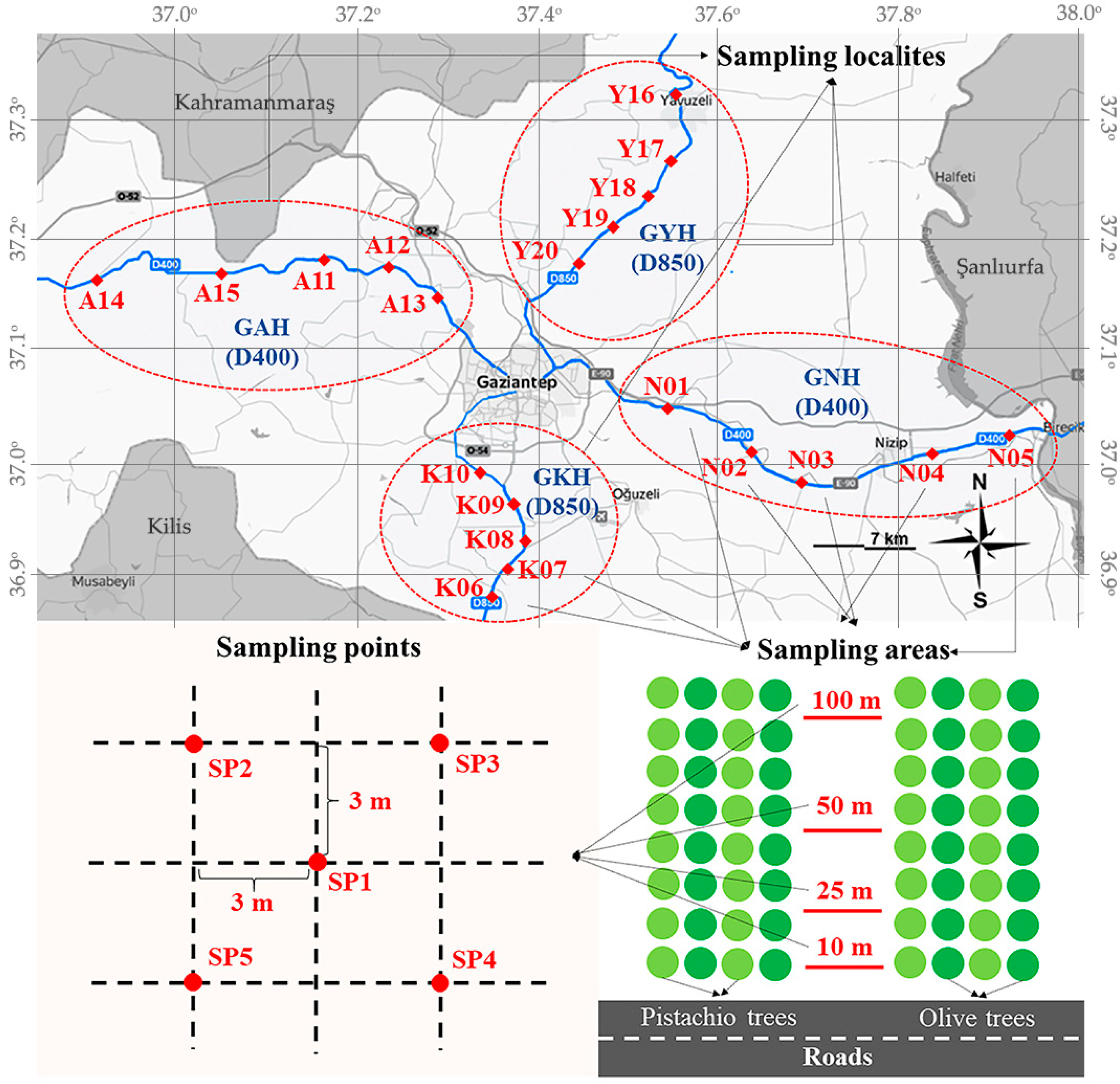
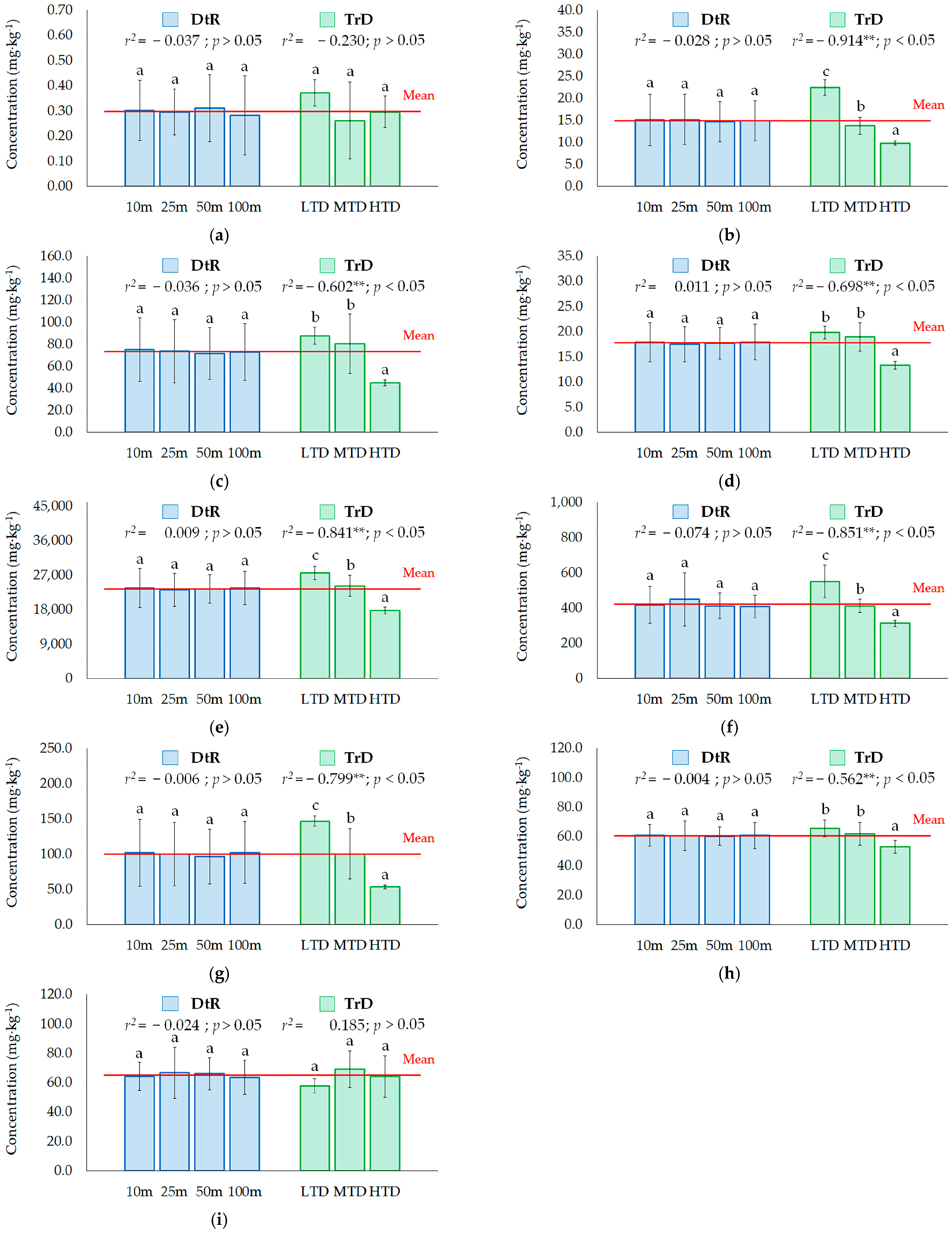
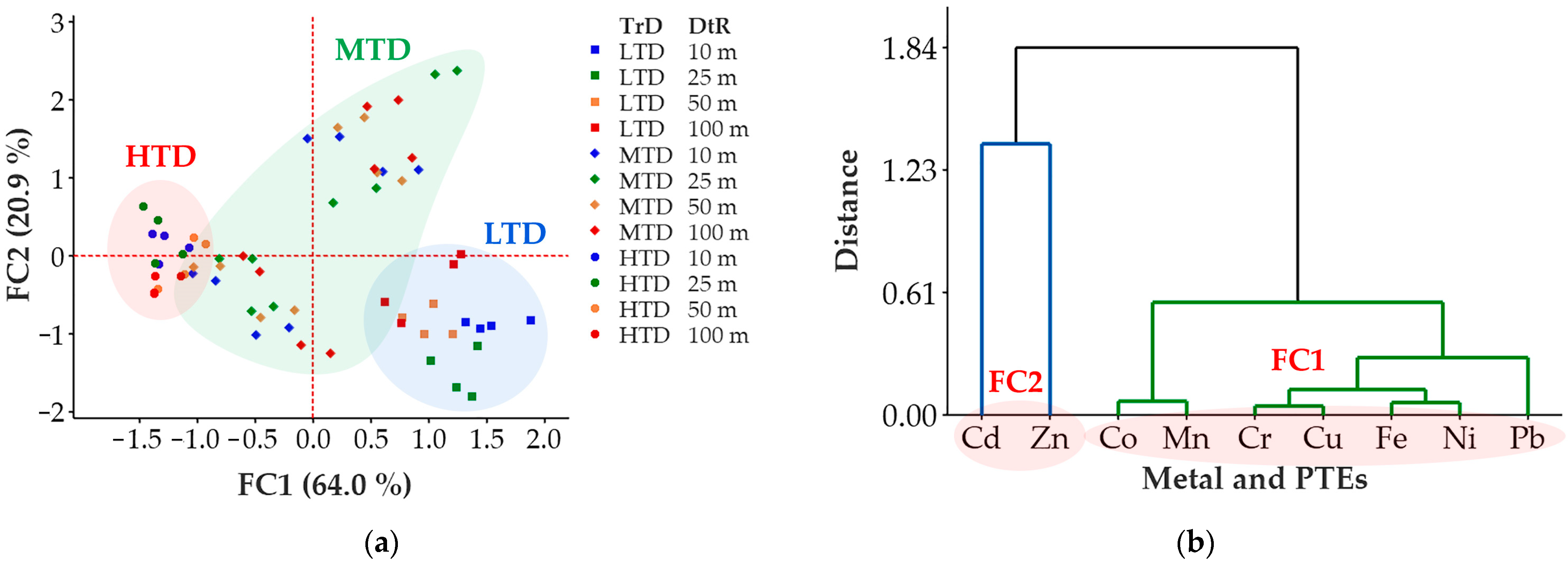
 , mean value.
, mean value.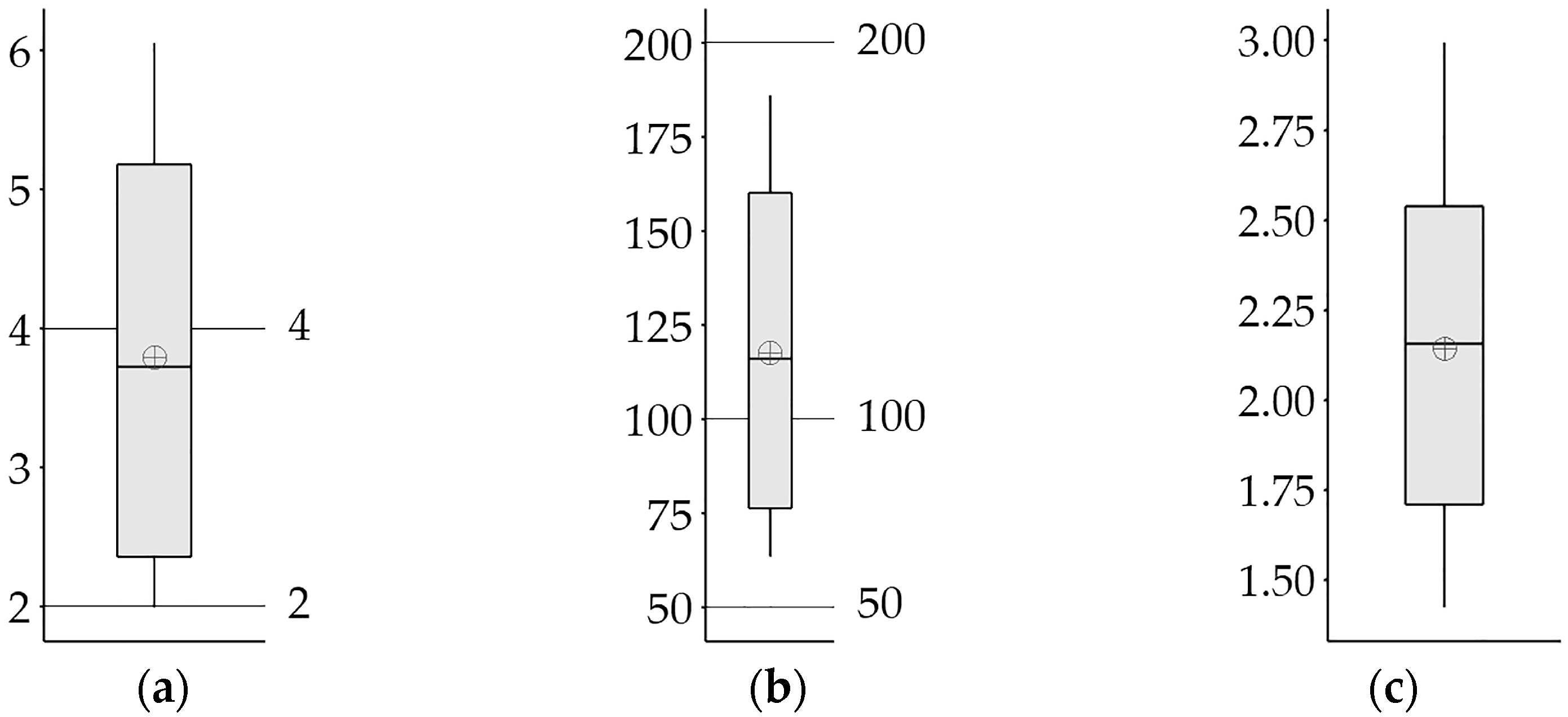
 , The mean value;
, The mean value;  , The outlier value.
, The outlier value.
 , The mean value;
, The mean value;  , The outlier value.
, The outlier value.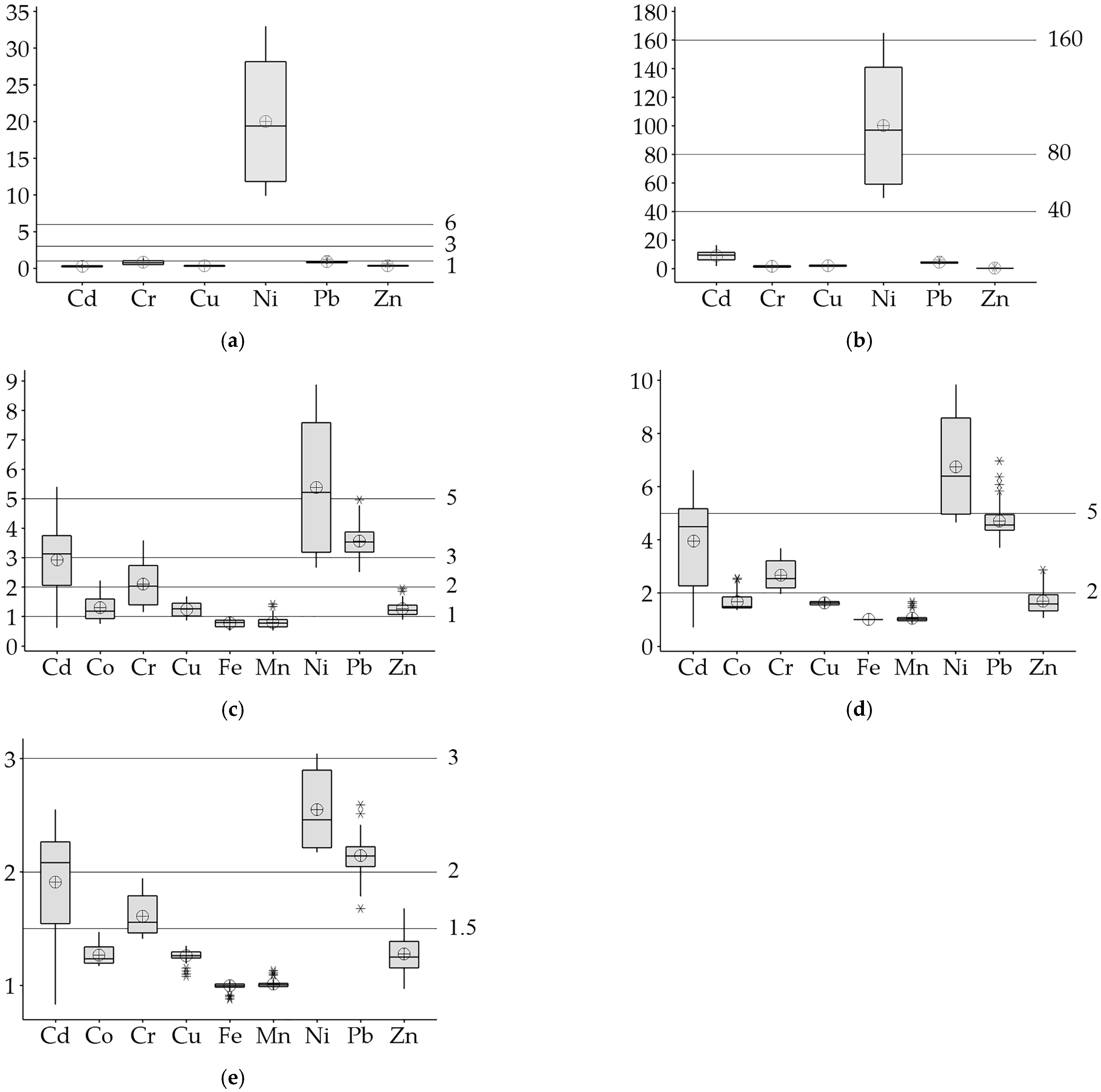
| pH | SOM (%) | IC (%) | Clay (%) | Silt (%) | Sand (%) | |||
|---|---|---|---|---|---|---|---|---|
| Distance to Road | 10 m (n = 20) | Mean | 7.92 a | 1.08 a | 19.44 a | 23.73 a | 51.00 a | 25.27 a |
| SD | ±0.01 | ±0.37 | ±11.66 | ±10.11 | ±8.98 | ±5.23 | ||
| 25 m (n = 20) | Mean | 7.92 a | 0.95 a | 20.07 a | 24.36 a | 48.13 a | 27.52 a | |
| SD | ±0.02 | ±0.52 | ±11.34 | ±9.49 | ±12.14 | ±4.63 | ||
| 50 m (n = 20) | Mean | 7.86 a | 0.96 a | 17.69 a | 23.36 a | 48.63 a | 28.02 a | |
| SD | ±0.06 | ±0.32 | ±12.10 | ±10.40 | ±11.30 | ±3.47 | ||
| 100 m (n = 20) | Mean | 7.91 a | 0.97 a | 16.07 a | 23.73 a | 47.00 a | 29.27 a | |
| SD | ±0.08 | ±0.47 | ±12.35 | ±11.22 | ±10.70 | ±5.64 | ||
| r2 | −0.237 | −0.080 | −0.124 | −0.012 | −0.125 | 0.296 | ||
| p-Value | 0.191 | 0.730 | 0.909 | 0.998 | 0.900 | 0.423 | ||
| Traffic Density | LTD (n = 20) | Mean | 7.88 a | 0.92 ab | 4.17 a | 23.42 b | 44.63 a | 31.96 b |
| SD | ±0.06 | ±0.15 | ±1.42 | ±3.50 | ±4.00 | ±1.41 | ||
| MTD (n = 40) | Mean | 7.90 a | 1.23 b | 17.19 b | 28.97 b | 43.81 a | 27.22 a | |
| SD | ±0.06 | ±0.42 | ±3.98 | ±9.41 | ±8.24 | ±4.82 | ||
| HTD (n = 20) | Mean | 7.92 a | 0.58 a | 34.70 c | 13.83 a | 62.50 b | 23.68 a | |
| SD | ±0.02 | ±0.10 | ±0.66 | ±7.09 | ±5.21 | ±3.27 | ||
| r2 | −0.294 | −0.356 * | 0.962 ** | −0.351 * | 0.617 ** | −0.619 ** | ||
| p-Value | 0.262 | 0.017 | 0.000 | 0.000 | 0.000 | 0.001 | ||
| Total (n = 80) | Mean | 7.90 | 0.99 | 18.31 | 23.79 | 48.69 | 27.52 | |
| SD | ±0.06 | ±0.41 | ±11.39 | ±9.82 | ±10.41 | ±4.80 | ||
| Min | 7.80 | 0.45 | 2.51 | 8.48 | 34.00 | 18.80 | ||
| Max | 8.01 | 1.90 | 35.55 | 39.20 | 68.00 | 37.52 | ||
| Kurt | −0.09 | −0.40 | −1.16 | −1.04 | −0.97 | −0.97 | ||
| Skew | −0.37 | 0.82 | 0.26 | −0.21 | 0.66 | 0.01 | ||
| CV (%) | 0.70 | 41.36 | 62.20 | 41.27 | 21.38 | 17.46 | ||
| Cd | Co | Cr | Cu | Fe | Mn | Ni | Pb | Zn | Ref. | ||
|---|---|---|---|---|---|---|---|---|---|---|---|
| Gaziantep | Mean | 0.30 | 14.93 | 73.30 | 17.74 | 23,407.36 | 421.78 | 100.20 | 60.38 | 65.03 | This study |
| SD | ±0.12 | ±4.94 | ±25.58 | ±3.35 | ±4183.76 | ±100.26 | ±41.92 | ±7.91 | ±12.19 | ||
| Min | 0.07 | 9.38 | 41.21 | 12.70 | 16,951.43 | 292.53 | 51.46 | 46.26 | 49.07 | ||
| Max | 0.53 | 24.73 | 122.66 | 23.57 | 29,891.92 | 725.52 | 159.58 | 82.78 | 98.91 | ||
| Kurt | −0.61 | −0.78 | −1.45 | −1.23 | −1.24 | 1.56 | −1.91 | 0.72 | 0.51 | ||
| Skew | −0.38 | 0.71 | 0.25 | −0.13 | −0.17 | 1.10 | 0.06 | 0.62 | 1.00 | ||
| CV (%) | 40.87 | 33.11 | 34.90 | 18.89 | 17.87 | 23.77 | 41.83 | 13.10 | 18.74 | ||
| Bursa * | 0.23 | 25.24 | 124.69 | 51.00 | 862.00 | 190.25 | 35.81 | 77.49 | [6] | ||
| Gaziantep ** | 0.70 | 15.00 | 73.00 | 27.00 | 118.00 | 14.00 | 58.00 | [56] | |||
| Gaziantep ** | 23,000.00 | 521.00 | [57] | ||||||||
| Malatya | 0.24 | 12.60 | 59.90 | 36.40 | 70.90 | 14.20 | 67.00 | [29] | |||
| Sinop | 194.73 | 43.19 | 39,848.57 | 85.02 | 17.01 | 65.10 | [12] | ||||
| Şanlıurfa | 16.00 | 85.00 | 27.00 | 37,505.00 | 679.00 | 89.00 | 10.60 | 68.00 | [11] | ||
| İsfahan | 0.43 | 14.70 | 85.90 | 35.70 | 28,000.00 | 649.90 | 66.20 | 34.60 | 111.40 | [5] | |
| Sulaimani *** | 0.22 | 29.90 | 7.41 | 107.00 | [13] | ||||||
| Peloponnese | 0.54 | 21.99 | 83.12 | 74.68 | 26,500.00 | 1020.50 | 146.80 | 19.74 | 74.88 | [26] | |
| Zagreb | 0.66 | 20.80 | 27,041.00 | 613.00 | 49.50 | 25.90 | 77.90 | [21] | |||
| Alicante | 0.34 | 7.10 | 26.50 | 22.50 | 13,608.00 | 295.00 | 20.90 | 22.80 | 52.80 | [10] | |
| Castellón | 0.36 | 7.90 | 32.20 | 35.40 | 17,487.00 | 408.00 | 19.90 | 56.10 | 76.80 | [25] | |
| LGV | pH 5–6 | 1.00 | 100.00 | 50.00 | 30.00 | 50.00 | 150.00 | [58] | |||
| pH > 6 | 3.00 | 100.00 | 140.00 | 75.00 | 300.00 | 300.00 | |||||
| WSA | 0.06 | 8.00 | 100.00 | 30.00 | 38,000.00 | 600.00 | 40.00 | 10.00 | 50.00 | [59] | |
| ESA | 0.22 | 13.20 | 111.00 | 23.68 | 28,407.00 | 684.00 | 52.00 | 17.79 | 92.00 | [60] | |
| UCC | 0.10 | 11.60 | 35.00 | 14.30 | 30,890.00 | 527.00 | 18.60 | 17.00 | 52.00 | [47] | |
| MAC | 5.00 | 50.00 | 200.00 | 150.00 | 60.00 | 300.00 | 300.00 | [23] | |||
| FC1 | FC2 | Comm | |
|---|---|---|---|
| Cd | −0.070 | −0.812 | 0.664 |
| Co | 0.940 | −0.247 | 0.945 |
| Cr | 0.878 | 0.444 | 0.968 |
| Cu | 0.903 | 0.314 | 0.914 |
| Fe | 0.973 | 0.053 | 0.950 |
| Mn | 0.894 | −0.265 | 0.869 |
| Ni | 0.965 | 0.170 | 0.960 |
| Pb | 0.779 | 0.366 | 0.741 |
| Zn | 0.029 | 0.793 | 0.629 |
| Variance | 5.760 | 1.880 | 7.640 |
| % of Var. | 64.0 | 20.9 | 84.9 |
| Cd | Co | Cr | Cu | Fe | Mn | Ni | Pb | Zn | |
|---|---|---|---|---|---|---|---|---|---|
| Co | 0.117 | ||||||||
| Cr | −0.290 | 0.815 ** | |||||||
| Cu | −0.185 | 0.842 ** | 0.962 ** | ||||||
| Fe | −0.026 | 0.923 ** | 0.913 ** | 0.937 ** | |||||
| Mn | 0.115 | 0.973 ** | 0.809 ** | 0.841 ** | 0.916 ** | ||||
| Ni | 0.078 | 0.970 ** | 0.860 ** | 0.887 ** | 0.963 ** | 0.943 ** | |||
| Pb | −0.201 | 0.780 ** | 0.850 ** | 0.845 ** | 0.853 ** | 0.741 ** | 0.824 ** | ||
| Zn | −0.296 | 0.000 | 0.245 | 0.309 | 0.120 | −0.020 | 0.088 | 0.182 | |
| pH | 0.438 * | −0.415 * | −0.550 ** | −0.553 ** | −0.508 ** | −0.355 * | −0.431 * | −0.540 ** | −0.324 |
| SOM | −0.358 * | 0.640 ** | 0.772 ** | 0.816 ** | 0.697 ** | 0.626 ** | 0.685 ** | 0.695 ** | 0.561 ** |
| IC | −0.065 | −0.911 ** | −0.728 ** | −0.758 ** | −0.857 ** | −0.905 ** | −0.879 ** | −0.712 ** | 0.026 |
| Clay | 0.357 * | 0.132 | 0.103 | 0.099 | 0.069 | 0.161 | 0.073 | 0.025 | −0.100 |
| Silt | −0.258 | −0.428 * | −0.389 * | −0.388 * | −0.368 * | −0.482 ** | −0.371 * | −0.278 | 0.082 |
| Sand | −0.197 | 0.774 ** | 0.720 ** | 0.740 ** | 0.762 ** | 0.799 ** | 0.768 ** | 0.637 ** | 0.046 |
Disclaimer/Publisher’s Note: The statements, opinions and data contained in all publications are solely those of the individual author(s) and contributor(s) and not of MDPI and/or the editor(s). MDPI and/or the editor(s) disclaim responsibility for any injury to people or property resulting from any ideas, methods, instructions or products referred to in the content. |
© 2023 by the authors. Licensee MDPI, Basel, Switzerland. This article is an open access article distributed under the terms and conditions of the Creative Commons Attribution (CC BY) license (https://creativecommons.org/licenses/by/4.0/).
Share and Cite
Demir, M.; Tunç, E.; Thiele-Bruhn, S.; Çelik, Ö.; Tsegai, A.T.; Aslan, N.; Arslan, S. Status, Sources and Assessment of Potentially Toxic Element (PTE) Contamination in Roadside Orchard Soils of Gaziantep (Türkiye). Int. J. Environ. Res. Public Health 2023, 20, 2467. https://doi.org/10.3390/ijerph20032467
Demir M, Tunç E, Thiele-Bruhn S, Çelik Ö, Tsegai AT, Aslan N, Arslan S. Status, Sources and Assessment of Potentially Toxic Element (PTE) Contamination in Roadside Orchard Soils of Gaziantep (Türkiye). International Journal of Environmental Research and Public Health. 2023; 20(3):2467. https://doi.org/10.3390/ijerph20032467
Chicago/Turabian StyleDemir, Mustafa, Erdihan Tunç, Sören Thiele-Bruhn, Ömer Çelik, Awet Tekeste Tsegai, Nevzat Aslan, and Sevgi Arslan. 2023. "Status, Sources and Assessment of Potentially Toxic Element (PTE) Contamination in Roadside Orchard Soils of Gaziantep (Türkiye)" International Journal of Environmental Research and Public Health 20, no. 3: 2467. https://doi.org/10.3390/ijerph20032467
APA StyleDemir, M., Tunç, E., Thiele-Bruhn, S., Çelik, Ö., Tsegai, A. T., Aslan, N., & Arslan, S. (2023). Status, Sources and Assessment of Potentially Toxic Element (PTE) Contamination in Roadside Orchard Soils of Gaziantep (Türkiye). International Journal of Environmental Research and Public Health, 20(3), 2467. https://doi.org/10.3390/ijerph20032467







